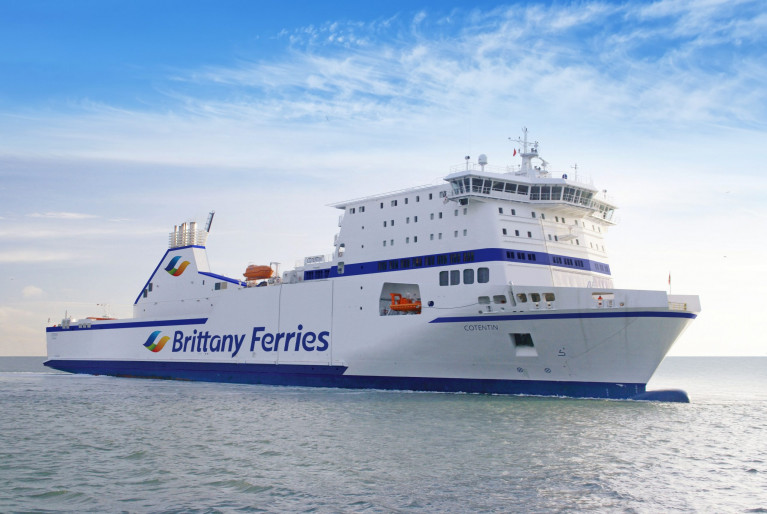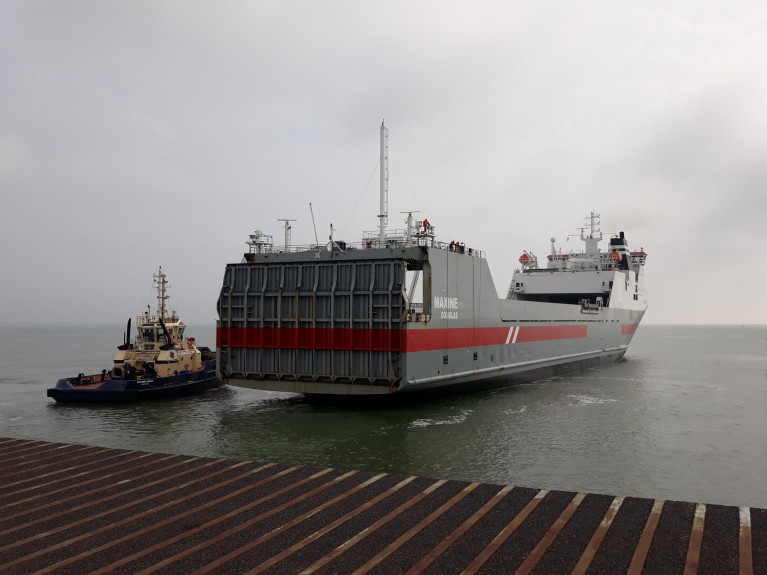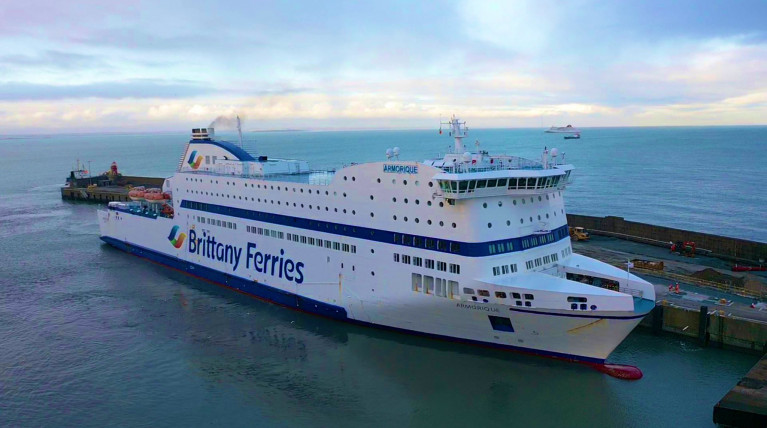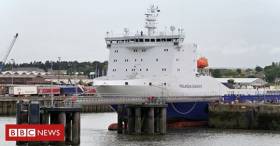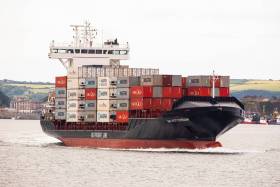Displaying items by tag: New Route
New Stena Line Route of Dublin-Liverpool Sees ‘Freight’ Crossings Completed with First Round Trip Today
Stena Line launched their new route of Dublin – Liverpool (Birkenhead) with the freight service completing its first round trip to the Irish capital in the early hours of this morning (16 February).
The addition of the new route is expected to further boost the company’s freight volumes following a record year on its Irish Sea services in 2023 in particular on Belfast-based routes to Cairnyan, Heysham and Liverpool where Stena already have an established route on Merseyside based out of Birkenhead.
The first sailing on the new service left Dublin Port’s Terminal 5 yesterday morning at 6:30am and arrived in Birkenhead (12 Quays Terminal) at 14.30hrs, where the Stena Horizon is temporarily operating on the new Dublin- Liverpool route. The vessel discharged and loaded freight vehicles for the evening return journey to Ireland, which involved a departure at 18.30hrs and an arrival at Dublin at 02.15hrs.
The addition of the new service will be Stena Line’s seventh route in the Irish Sea region complementing its Belfast - Cairnryan, Belfast – Heysham, Belfast – Liverpool, Dublin – Holyhead, Rosslare – Fishguard and Rosslare – Cherbourg services.
With Stena Horizon initially operating on the Irish Sea central corridor route, the company is currently assessing ship deployment options for a permanent freight-only vessel. The new service will provide freight customers on both sides of the Irish Sea with even more choice when it comes to securing an efficient and reliable connection between Ireland and Britain.
Paul Grant, Trade Director (Irish Sea), Stena Line said: “We are excited to launch our much-anticipated new freight route between Dublin and Liverpool, securing a key trading route across the Irish Sea. With two services now operating from both Dublin Port and 12 Quays in Birkenhead, we’re expanding our operational hubs in both ports creating more efficiencies for our customers. Currently, we have deployed the Stena Horizon temporarily, but we hope to be able to confirm a permanent solution soon that will help to maximise freight capacity and boost trade volumes.”
Barry O’Connell, CEO, Dublin Port Company, said: “We are pleased to welcome Stena Line’s new Dublin-Liverpool route, which will provide freight customers with a choice of routes across the Irish Sea. It is essential to the Irish economy that we have strong, reliable connections to Great Britain and this dedicated freight service helps to secure a key trading corridor.”
In 2023, Stena Line signed an agreement with Peel Ports to operate at the 12 Quays Terminal until the year 2100, demonstrating the company’s long-term commitment to the region.
Phil Hall, Port Director Liverpool, Peel Ports Group said: “We are delighted to be supporting this new freight route as part of our long-standing partnership programme with Stena Line, which further enhances trade opportunities, efficiency and capability for our customers.“
The ferry operator transports 6.5 million passengers with 38 vessels across 18 routes in Northern Europe operating 26,000 sailings each year.
A major new ferry connection of a Cork-Europe route this Spring/early Summer looks likely as a company is reported to be in the final stage of starting the direct link to Boulogne in northern France.
As Cork Beo reports, plans of the Ireland-France route by a new operator, Hibernia Line, would run six days a week using a ropax ferry, with passengers having 350-berth cabins along with space dedicated for freight capacity.
The direct route would provide a great link for Cork based businesses and open up brand new options to those travelling to and from mainland Europe. The Port of Boulogne is close to the borders of the lowland nations, Paris (Olympics) and beyond the tourist attractions of the Alps.
According to a speciality ferry/freight sector sources, the newly formed Hibernia Line, which could be operated on a joint basis involving established ferry operators. Such discussions are at an advanced stage of completing plans of the Ireland-EU member state route.
More here on this ferry development.
Afloat.ie adds, the nearest equivalent to the Hibernia Line route is DFDS existing Rosslare-Dunkirk route which began in January, 2021 as a Brexit-Busting freight-only alternative to the UK land-bridge. A 'trial' passenger service took place last year, whereas 2024 is to offer an expanded such service due to high demand.
If the new Hibernia Line launches, Afloat adds the direct-continental route would be geographically (the longest ‘passenger’ route based out of Cork to France), since Irish Ferries served to Le Havre until ceasing the connection more than a quarter century ago.
The Munster-Normandy route of Irish Ferries had taken 21 hours 30 minutes, whereas the current DFDS Ireland-France route is some 23-24 hours. As for the Hibernia Line link would be around 15-20 hours passage time using faster ferries compared to those of the past.
As Freight Demand Surges, Brittany Ferries Announce New Link of Le Havre-Rosslare Europort
Brittany Ferries has announced a new weekly freight service linking Le Havre in Normandy with Rosslare Europort in Ireland.
The direct route (to mainland Europe) will be served by Cotentin, Brittany Ferries’ freight-only vessel and will commence next week, with an inaugural sailing on Friday 12th November.
The schedule will see Cotentin leaving Le Havre on Friday evening, arriving in Rosslare on Saturday afternoon. The freight ferry's return leg will depart Rosslare on Saturday evening, arriving in Le Havre on Sunday at 15:00.
The schedule will see Cotentin leaving Le Havre on Friday evening, arriving in Rosslare on Saturday afternoon. The return leg will depart Rosslare on Saturday evening, arriving in Le Havre on Sunday at 15:00.
|
Le Havre – Rosslare : Cotentin’s schedule |
|||
|
Depart |
Le Havre |
Friday |
19:00 |
|
Arrive |
Rosslare |
Saturday |
14:30 |
|
Depart |
Rosslare |
Saturday |
17:45 |
|
Arrive |
Le Havre |
Sunday |
15:00 |
The move follows a significant increase in demand for direct freight links connecting Ireland with France. Since the beginning of September Brittany Ferries has reported a 76% increase in weekly freight carried, compared with the first eight months of the year.
“Thanks to flexibility in our fleet and agility in our operations, we have been able to move quickly to meet growing demand,” said Christophe Mathieu, Brittany Ferries chief executive officer. “Brexit has delivered more headaches than opportunities, particularly on routes serving the UK and France. However, the so-called Brexit by-pass, where freight operations avoid the UK completely, is one area that has worked to our advantage.”
Cotentin re-joined the Brittany Ferries fleet in January 2021. Built in 2007, she is 165 metres long with space for 120 freight units. The ship features 120 cabins and a range of amenities for drivers including a restaurant, bar and shop.
This new route will complement the Cherbourg - Rosslare service, operated by Brittany Ferries with Connemara since the beginning of 2020.
Jean-Marc Roué, Brittany Ferries’ president comments, "The red, white and blue of the French Tricolore must be flown on the routes to Ireland from Brittany and Normandy. And who better than Brittany Ferries, the largest employer of French seafarers, to display them proudly? This new route between Le Havre and Rosslare is an important step. The biggest French port should have its own freight link to Ireland.
“Economically, it’s obvious. In almost a year, the number of freight vehicles transported by sea from Ireland has tripled. I have no doubt that the imposition of control measures on the UK-Ireland landbridge at the beginning of 2022 will further strengthen this appetite for the sea alternative, and that this Le Havre/Rosslare route has a bright future.
“But it is also strategically essential for our Company: we must be present wherever there’s a real potential for growth as part of our return to competitivity. Our experience sailing to Ireland, both from Cherbourg and from Brittany, is compelling enough for us to embark on this adventure, creating a new route between our two countries.”
Surging demand on services linking Ireland with France, mirrors a sharp rise in freight carried between Ireland and Spain.
The company is regularly carrying more than 1,000 freight units a month on its seaborne route connecting Rosslare with Bilbao. In the first eight months of the year, demand rose 70 percent compared with 2020 figures.
Ferry lanes linking Ireland with Spain were opened for the first time by Brittany Ferries in 2018. The Rosslare-Bilbao route has since become an important artery for hauliers and logistics operators.
The Rosslare-Bilbao service operates twice weekly in each direction, with sailings from Rosslare on Wednesdays and Fridays, and from Bilbao on Thursdays and Sunday.
In the UK, the Peel Ports Group through its London Medway area of operations has welcomed DFDS new England-France freight-only ferry route connecting Sheerness and Calais that is to begin service this month.
The new freight route offers one daily sailing in each direction between the two ports using the ro-ro Maxine, which can carry up to 165 unaccompanied freight units - which are trailers or containers without drivers.
This latest development expands DFDS’ existing network of services between the UK and Europe and comes in response to growing demand for unaccompanied freight services from cargo owners, hauliers and shipping lines alike.
Most of the unaccompanied freight carried today by DFDS on the two Dover Strait routes – Dover-Calais and Dover-Dunkirk – is expected to be transferred to the new route.
(Noting Afloat adds in January, DFDS launched a direct Ireland-France service connecting Rosslare Europort and Dunkirk, to provide freight hauliers an alternative to a post-Brexit UK landbridge to mainland Europe).
As for the Port of Sheerness located in north Kent, the port offers excellent into and around the UK. It operates 24 hours a day and is fully open and accessible seven days a week, offering congestion free access to drop and collect trailers.
Owner Peel Ports has invested heavily into enhancing its facilities and services, making it the perfect port to accommodate this new service.
The combination of challenges posed by Brexit and Covid-19, has exposed drivers and haulage companies to vulnerabilities in supply chains worldwide.
This has resulted in many cargo owners and carriers re-assessing their transport plans and choosing different ports, different shipping methods and switching transport modes to future proof supply chains.
The partnership between DFDS and Peel Ports will create up to 100 new jobs in the region, with recruitment already underway for many of these roles.
Maxine's sailing roster will involve a daily arrival into Sheerness at 05.00 and from where it will be unloaded and reloaded to make its return journey back to Calais at 11.00.
French Operator's 'Brexit-Bypass' New Freight Route Direct from Ireland to 'Brittany' (Tonight)
Once again another 'Brexit bypass' ferry but by Brittany Ferries begins operating this evening (8pm/2000hrs) on a new 'freight' route of Ireland-France through St. Malo, which is a first to connect Wexford and the French region, writes Jehan Ashmore.
As part of the ongoing developments since the UK left the EU, Irish hauliers have been demanding direct ro-ro routes to marketplaces in mainland Europe. This to avoid Brexit/EU border customs paperwork and potential delays on the UK land-bridge on the Irish Sea and especially through Dover.
According to Brittany Ferries, the first sailing takes place from Rosslare (Europort) Harbour this evening so to transport Irish lorries and their drivers to the Breton town of St Malo. The ferry operator (as of a lunchtime today) had reported that space was available on board.
The new routes form part of an enhanced 'freight' network to be introduced by Brittany Ferries: they are Rosslare-St. Malo, Rosslare-Roscoff in addition Cork-St. Malo and Cork-Roscoff. In addition Brittany already operate a Rosslare-Bilbao route in northern Spain.
Last year a short-lived Rosslare-Roscoff 'seasonal' (then with passengers) route was inaugurated but was abandoned in favour of the Cherbourg at hauliers preferred the transport hub of Cherbourg, so it appears the former route will prove less popular.
The port of Roscoff, was where the humble origins of the company began by exporting Breton based vegetables to Plymouth. This took place on 2 January 1973 using the freight only Kerisnel that entered service only 24 hours after Great Britain's entry into the common market of the European Economic Community (EEC) now the EU.
As for the Armorique, the cruiseferry's career began in 2009 on the Roscoff-Plymouth route and taking the same name of a predecessor that during the 1970's assisted the company in becoming the largest operator on the western English Channel, Ireland and Spain.
The debut of Armorique tonight follows in the wake of that original Armorique that incidentally was chartered to Irish Ferries and out of Rosslare in 1989 (Afloat will have a reflective piece on this).
As for these new developments, the Cork-St. Malo route is another 'freight' first for Brittany though a passenger service existed in 1990's. So the boost out of Cork (to Santander closed last year) is consolidated and as the only operator using the southern port to Brittany. There will be three round trips each week, with departures from Cork on Tuesdays and Saturdays, and from Rosslare on Thursdays.
This is the French operator's second response to a Brexit-Bypass solution as they opened a Rosslare-Cherbourg service last month, initially served Cap Finistère.
A ropax, Connemara of the popular 'Visentini' built series is to takeover later this month as Afloat reported before but in this update the sailing is confirmed to be next Monday, and outward of Rosslare.
As detailed below is Amorique's four route network and sailing schedule
Day Depart Time Arrive Time (next day)
Monday Roscoff 20:00 Cork 14:00
Tuesday Cork 20:00 Roscoff 14:00
Wednesday Roscoff 20:00 Rosslare 14:00
Thursday Rosslare 20:00 St Malo 17:10
Friday St Malo 20:00 Cork 15:00
Saturday Cork 18:00 Roscoff 12:40
NOTE: Timetables are subject to weekly variation and change at short notice
As previously highlighted, Armorique is to operate the new route linking Leinster and Brittany, though in 2019 the ferry had stood in covering the 'seasonal' Cork-Roscoff route taking 'holidaymaker's along with motorist cars and freight vehicles.
Since the custom built cruiseferry Armorique entered service, it had usually taken holidaymakers from UK to France having made a debut on the Breton-Cornwall route as alluded above. In addition to relief duties on the English Channel including Portsmouth-Caen as Afloat reported some years back.
Afloat yesterday tracked Armorique having departed from a period of been laid-up in Le Havre. The cruiseferry from there made the short coastal passage to Caen (Ouistreham) in Normandy, where a terminal was custom built for Brittany Ferries to inaugurate in 1986 a new route to Portsmouth.
Brexit Time: Ferry Route Planned from Scotland to Netherlands
A shipping company based in Scotland is planning to start a daily ferry service linking Rosyth with the Netherlands.
Operations according to BBC News Scotland, would start around the time that Brexit is scheduled by the Westminster government.
That could make such a route a vital link for freight, if there are delays on crossings further south.
The ferry service would run between the Fife port and Groningen Seaport at Eemshaven, in the far north of the Netherlands near the German border.
News of the service first broke through Dutch news service RTV Noord, and was confirmed by David Kellas, director at TEC Offshore.
Offshore Activities
He explained the Perthshire-based company already has a wide portfolio of offshore activities.
These include drill ships, dive boats, floating oil and gas production vessels and floating accommodation for offshore workers.
He told BBC Scotland: "Eeemshaven is a more central port than people give it credit for".
However, it is not usually used for passenger services, and arrangements for that are still being discussed.
The operation would involve chartering two ships, each carrying up to 2,000 passengers.
Zeebrugge Service
There was a passenger ferry service between Rosyth and Zeebrugge in Belgium between 2002 and 2010. It became a freight-only operation until 2018 as Afloat previously reported.
For more click this link about the North Sea ferry development.
Port of Waterford: New Freight Route to Rotterdam Opens
The Port of Waterford has a new freight shipping route to Rotterdam which has opened a new pathway between Ireland and the continent which could help exporters post-Brexit.
The first sailing on the Waterford-Rotterdam route, RTE reports, is operated by Dutch company BG Freight Line in partnership with container shipping multi-national Maersk, took place last Saturday and will be a weekly fixture between the southeast and the continent.
Executives from the Port of Waterford and Maersk are due to meet business figures from the region this evening to outline details of the new route and the opportunities it will provide.
The development comes as the Cabinet discusses contingency plans for Brexit, including preparations at ports and airports.
More on this port development can be read here.


























